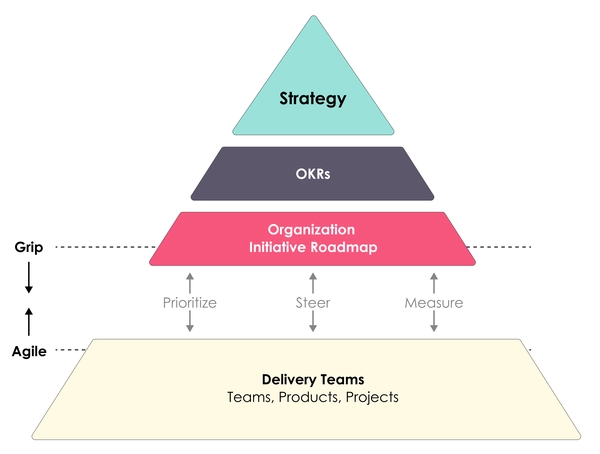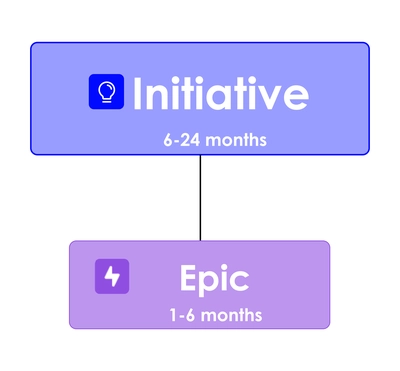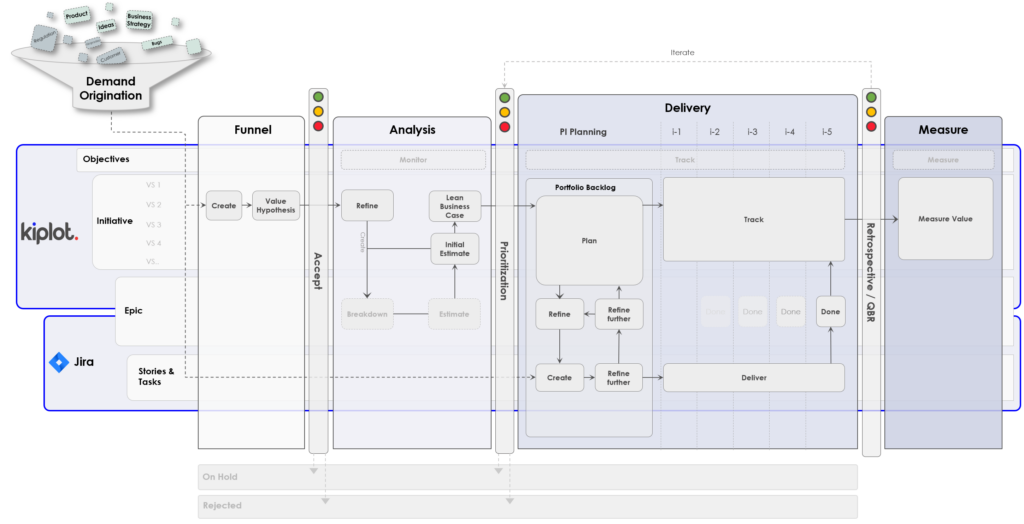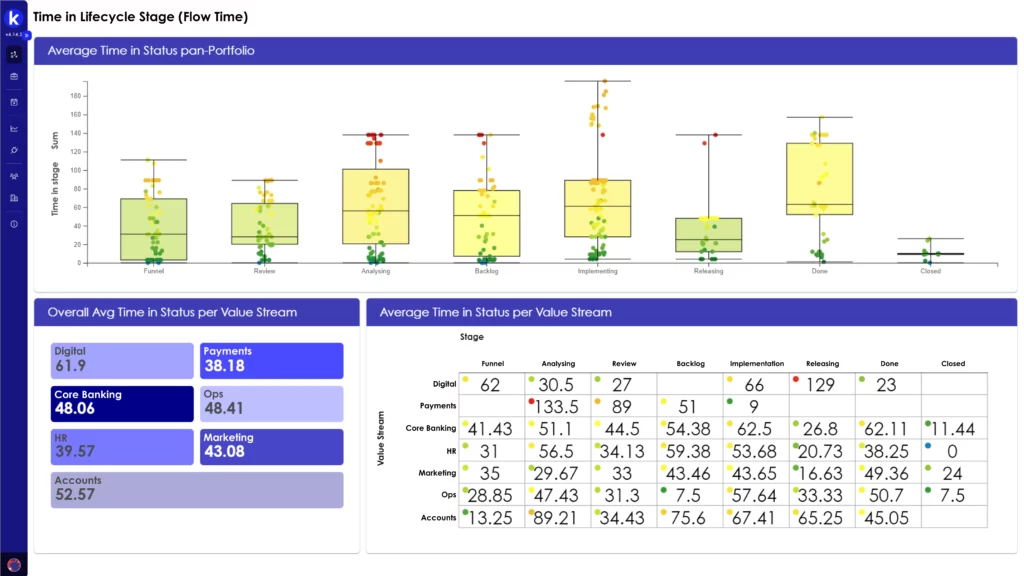Portfolio Planning
The importance of grip in agile transformation
Introduction
The term "grip" refers to the degree of control, influence, or oversight that management has over the operations, processes, and decision-making within an organization. The term encapsulates how tightly an organization's leadership steers the direction of the company, manages its resources, and ensures that activities align with strategic goals.
The idea of “grip” is typically associated with a command and control approach to organizational management and as a result, is often misunderstood as the antithesis of agility. However, grip is critical to a successful agile transformation, especially in large organizations. Too often “the baby is thrown out with the bath water” in pursuit of agile, and the organizational steering wheel is inadvertently removed.
In this article, we’ll explore how Steve Jobs, exemplifies the balance of maintaining “grip” while fostering agility. His leadership at Apple demonstrated that “grip”, when applied correctly, does not stifle agility but rather, is a catalyst for it. We will look at the importance of combining agile with “grip” and explore three powerful strategies that will enable your organization to drive agility, while retaining the right level of control.

Steve Jobs and grip
“It doesn't make sense to hire smart people and tell them what to do; we hire smart people so they can tell us what to do.” – Steve Jobs
This frequently cited Steve Jobs quote is often misconstrued to support the idea of completely autonomous, self-directed teams utilizing their greater knowledge of the customer to initiate their own projects and manage their own “backlogs”.
This interpretation misremembers that Jobs was an infamous control freak. The idea that individuals at Apple had free rein to pursue significant ideas without Jobs' approval is nearly farcical. In fact, when Jobs returned from exile to lead Apple for the second time, the first thing he did was to kill most of the projects that the organization was working on. Over two years, Apple went from 350 products to just 10. He replaced these projects with a coherent strategy that was underpinned by clearly defined initiatives. He gripped the organization, and directed it to successfully achieve his goals.
Yet, this control was the framework within which innovation flourished, not a barrier to it.
Jobs’ approach was not pure command and control. Critically, he combined grip with a relentless focus on building the frameworks, processes and culture that fostered creativity and empowered teams to solve the seemingly impossible challenges he put in front of them. He gave autonomy, authority and decision making power to teams to solve the hardest problems and build the best solutions to bring his initiatives to life. But he did not empower them to determine the company’s direction. He determined the “what” and empowered teams to focus on the “how”.
Let’s look at a specific example of the balance in grip and empowerment that Jobs routinely applied.

Gripping the iPhone keyboard
During the development of the first iPhone, Apple faced internal debates about its user interface, particularly the input method. While traditional and early smartphones featured physical keyboards, Jobs pushed for a radical departure: a software-based touchscreen keyboard. This vision aimed to maximize usability and screen real estate. Jobs was insistent in his vision, despite significant challenges such as inaccurate typing, slow response times, and even user frustration in early tests.
Jobs' insistence on this vision showcased his leadership style – firm grip combined with a clear vision and the freedom for innovation. Personally driving the team to overcome skepticism and technical hurdles, Jobs's approach wasn't just about enforcing his will; it was about fostering a culture where challenging the status quo and pursuing precision in innovation were valued. This environment enabled his team to deliver groundbreaking engineering solutions, turning Jobs' ambitious vision for the iPhone's user interface into reality.
So how do we build systems, processes and frameworks that allow us to balance grip, with agility? Read on…
Principle 1: Origination
“Focus is about saying NO.” – Steve Jobs
Balancing control and agility necessitates maintaining a firm grip on the initiation of new initiatives. Allowing complete devolution to teams will dilute strategic focus.
When we think of an initiative in this context, we’re talking about the highest level of activity in your organizational work hierarchy. We would typically say that an initiative might last between 6-24 months.
Originating initiatives is about saying “Yes”. But doing this successfully, involves saying “No”, a lot. To do this, organizations must have a clear origination funnel, and retain grip over it.
Strategic control over initiative origination must seek to guide rather than constrain, ensuring agility operates within a strategic framework aligned with the organization's goals.

By ensuring Epics and stories from teams within the Value Streams tie back to approved Initiatives, we ensure team-level innovation and agility contribute to strategic outcomes. This balance of strategic control and team autonomy mirrors Jobs' leadership at Apple, blending agile flexibility with strategic clarity and direction.
Below is an example diagram demonstrating how you can set up this demand origination funnel.

Further reading:
Architecting Jira for large organizations
The Outsiders: Eight Unconventional CEOs and Their Radically Rational Blueprint for Success.
Principle 2: Aggressive transparency
“Simple can be harder than complex: You have to work hard to get your thinking clean to make it simple. But it’s worth it in the end because once you get there, you can move mountains.” – Steve Jobs
In the spirit of Jobs’ relentless pursuit of simplicity and clarity, the second principle to follow is aggressive transparency. It is critical that you don’t lose your organization to a sea of Jira tickets where progress tracking is obscured by spreadsheets and PowerPoint presentations. Just as Jobs emphasized the importance of clean, simple thinking, so too must organizations strive for simplicity and clarity in tracking and communicating their progress and challenges.
To avoid the clutter and confusion that can hide true progress and issues, organizations, and particularly lean portfolio management (LPM) teams, must obsess over enforcing work hierarchy and driving adoption of associated data transparency. This effort aligns with Jobs's approach: making complex systems understandable and manageable through simplicity and clarity. The following foundational metrics will help you retain visibility of where capacity is being utilized, ensuring that every team member and stakeholder has a clear understanding of the organization's direction and progress.
Capacity consumed per initiative and epic
Are we spending an appropriate amount of time on production support and tech debt? Or are we spending all of our time on a white elephant initiative that we began as an MVP-led experiment. Transparency drives “real” prioritization conversations and allows leadership teams to exercise their “grip” to adjust focus where necessary.
Data quality score
Implementing a data quality score is an excellent way to assure the quality of the data that the organization is using to monitor progress. We typically see that organizations can overthink this. In the first instance, a naive score that tracks foundational data quality is a powerful starting point. Foundationally, the data quality score should include a view of orphaned epics, epics in delivery without due dates, epics scheduled without a team assigned, epics scheduled without estimates etc.
Foundational Flow metrics
Flow metrics enable the organization to “see” the work flowing from beginning to end. A critical tip here is to start with the basics (i.e. focus on MVP), rather than getting lost attempting to implement metrics that the organization is not yet ready for. Here are some examples examples of where to start:
| Foundational Flow Metric | Description |
|---|---|
| Unit velocity | Measuring unit velocity is a simple starting point to see the volume of issues travelling through our workflow. We can, in the first instance, ignore estimates (i.e. story points) and simply focus on the number of “widgets” (epics or stories) completed in a given period. Remember not to compare the relative performance of teams – what we’re looking for here is the absence of lumpy flow. This is less about “speed” (that will come later) and more about foundational ways of working. |
| Time in stage | Measuring average time in stage, especially at Epic level also helps to provide visibility into workflow. Again, this is less about speed in the first instance, and more about focusing on numbers in the middle of your lifecycle not continuing to grow. |

Further reading:
Measure What Matters: The Simple Idea that Drives 10x Growth
Principle 3: Implement QBRs
“You have to be ruthless if you want to build a team of A players.” – Steve Jobs
Steve Jobs's approach to building successful teams centered not just on talent, but on cultivating an environment of accountability, clarity, and strategic decision-making. This philosophy is at the heart of Quarterly Business Reviews (QBRs). In this context, ruthlessness should be interpreted as an uncompromising commitment to excellence, clarity, and accountability—key attributes that QBRs seek to enforce within an organization.
Implemented effectively, QBRs foster a culture of heightened accountability, ensuring the organization maintains strategic "grip” over its agile operating model. We use the QBR to reflect, course correct, steer and provide leadership.
Through QBRs, the organization, especially its leadership, gains the opportunity to:
- Review progress against inflight initiatives – in particular value achieved against forecast
- Review flow metric progress
- Originate new initiatives
- Choose to close, pause or reject existing initiatives
- Review resource and capital allocation
It is also worth noting that PI Planning (program increment planning) and QBRs are complimentary concepts, and certainly not mutually exclusive. The output from QBRs can work well as a key input to PI Planning (typically a few days later). In this context, PI Planning can be see as a lower level, delivery orientated event that seeks to enact the plan that the QBR has set out.
Further reading:
McKinsey & Company – Quarterly Business Review: How to extract benefits beyond transparency
Conclusion
Embracing Steve Jobs's philosophy, the intertwining of firm 'grip' with agile practices enables organizations to navigate the complexities of innovation and change effectively. By applying the principles of origination, transparency, and strategic reviews, organizations can foster environments where agility and control coexist to achieve transformational outcomes.






